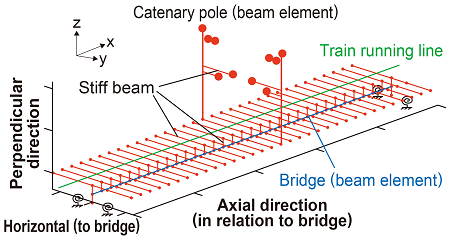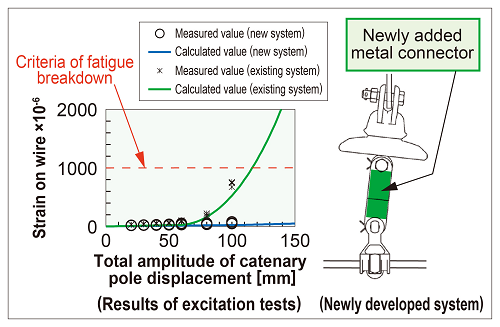8. Measures for reducing damage to overhead contact line system due to bridge oscillations caused by passing trains
On some sections of simple-support bridges, wire fatigue failures in overhead contact line systems have occurred due to large bridge oscillations caused by passing trains. The amplitude of bridge and catenary pole oscillation depends on their type and design.
Consequently, it is necessary to clarify what conditions of bridge and catenary pole lead to wire fatigue failure, and to identify the criteria that determine whether measures have to be taken or not.
A computation method of coupled oscillation between bridges and catenary poles (Fig. 1) was developed to be able to calculate their complex coupled oscillation. It was found that calculated response displacements coincided with measured values.
This new computation method is therefore able to reveal the conditions that cause larger oscillations in overhead contact line systems.
These results can be used to screen which existing bridges have conditions that are likely to cause wire fatigue failure, and to select which measures should be applied to prevent damage.
The total amplitude of catenary-pole displacement that causes wire fatigue failures was then clarified. When the total amplitude exceeds 50 mm, insulator rotation is restricted, resulting in a tremendous strain on the wire. Consequently, a new metal fitting was developed to reduce this strain (Fig. 2). In addition, a decision-making flow chart was proposed to determine whether measures had to be taken or not (Fig. 3).
Other Contents
- 1. Real-time hazard mapping system for localized heavy rainfall-induced disasters
- 2. Earthing system testing device for lightning protection in power supply installations
- 3. Vertical damper to suppress decrease in wheel load on container wagon bogies
- 4. Seismic reinforcement methods for improving anti-catastrophe performance of railway viaducts
- 5. Support System for verifying evacuation safety in case of station fire
- 6. Early railway line tsunami inundation forecasting method
- 7. System for determining the stability of slopes during snowmelt season
- 8. Measures for reducing damage to overhead contact line system due to bridge oscillations caused by passing trains
- 9. VR-based training to prevent man-vehicle collision accidents
- 10. Method for evaluating train running safety during earthquakes considering non-linear behaviour of structures
- 11. Critical wind speed of overturning based on actual measured lateral vibration acceleration
- 1. Real-time hazard mapping system for localized heavy rainfall-induced disasters
- 2. Earthing system testing device for lightning protection in power supply installations
- 3. Vertical damper to suppress decrease in wheel load on container wagon bogies
- 4. Seismic reinforcement methods for improving anti-catastrophe performance of railway viaducts
- 5. Support System for verifying evacuation safety in case of station fire
- 6. Early railway line tsunami inundation forecasting method
- 7. System for determining the stability of slopes during snowmelt season
- 8. Measures for reducing damage to overhead contact line system due to bridge oscillations caused by passing trains
- 9. VR-based training to prevent man-vehicle collision accidents
- 10. Method for evaluating train running safety during earthquakes considering non-linear behaviour of structures
- 11. Critical wind speed of overturning based on actual measured lateral vibration acceleration



